Sugar Cane vs Sugar Beet

Sugar, namely sucrose, is a well-known carbohydrate which intrinsically found in most fruits and vegetables and produced because of photosynthesis. Sugar cane and sugar beet are two different plants high in sucrose and commonly consumed as table sugar. After the brief history of sugar, let us start by explaining sugar cane and sugar beet.
Before the 1750s, sugar production was entirely limited to sugar cane growing in the tropics. The German chemist extracted sugar from sugar beet, which was used mainly as animal feed, and realized that this sugar, namely sucrose, was the same as cane sugar. In due course, the large-scale production of sugar beet has been developed because of its tolerance to different climates and soils. Due to economic embargoes applied and the limited availability of sugar cane, the European continent developed its sugar industry by producing its sugar from sugar beet. Afterwards, at the end of the 19th century, the United States of America introduced sugar production with sugar beet (Finkenstadt, 2013).
Sugarcane (Saccharum officinarum) is a perennial grass mainly grown in tropical and subtropical regions. According to Cheesman (2004), the sugarcane plant has many stalks that reach 3 to 7 m long and bear long sword-shaped leaves. The stalks are comprised of many parts, and they have buds at each junction point. As cane gets mature, the growing point at the upper end of the stalk turns into a slender arrow bearing a tassel composed of tiny flowers.
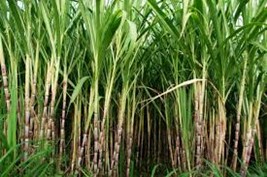
Figure 1. Sugar cane plant
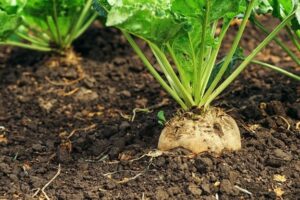
Sugar beets belong to the Beta vulgaris species, and sugar is extracted from the root of the plant. In addition, by-products such as greens, molasses, and pulp residue serve as raw materials for different purposes, and thus the whole beet is utilized. The sucrose content of sugar beet is between 16-20% on a fresh weight (FW) basis, lying on the cultivation and growing conditions (Duraisam et al., 2017).
Figure 2. Sugar beet plant
There are similarities and differences between sugar cane and sugar beet. These can be physical, structural, functional, or operational. Here are some similarities and differences.
Firstly, Cheesman (2004) states that sugar cane is a perennial grass that grows in tropical climates, and parts of the cane stalks are re-planted occasionally. On the other hand, sugar beet is an annual plant growing in slightly wider climate conditions and breeds flowers’ seeds.
Sugar beet does not deteriorate as quickly after harvest as sugarcane, so the entire crop can be harvested. When preserving sugar beet after harvest, it is important whether stored at room temperature or frozen because the sugar content changes depending on its state. Keeping it in its initial state leads to loss of efficiency.
FAO (1994) summarizes the contents of plants as follows; both sugar cane and sugar beet have a high-water content of about 75%, and both have little protein and fat content. Moreover, sugar cane has a sugar content of 10-15% of the total weight, while sugar beet depends on the storage conditions after harvesting.
Sugars from both sources are almost chemically identical, and their purity is generally greater than 99% (Urbanus, 2014).
Sugar beet has more nitrogen content than cane sugar because it is the root, and this nitrogen content can affect specific processing steps (Cheesman, 2004).
The carbon fixation process, a pathway for autotrophs where CO2 is converted into organic compounds, differs between in sugar beet and sugar cane. C3 and C4 are the two main photosynthetic pathways here. Sugar beet, a C3 plant, uses the Calvin cycles in the initial phase, which results in the formation of a 3- carbon compound as the first stable intermediate. On the other hand, sugar cane is a C4 plant that fixes carbon dioxide into a 4-carbon compound before starting the Calvin cycle. C3 plants (e.g., sugar beet) are frequently cultivated in temperate zones, while C4 plants (e.g., sugar cane) are grown in hot regions. By means of isotope ratio mass spectrometry (IRMS), the 13C / 12C ratio, distinguishing C3 and C4 plants can be determined. So, we can say that sugar cane and sugar beet are distinct in their carbon isotope ratios, which indicates the variation in the photosynthetic pathways used. The carbon isotope ratio of beet is around 25%, meantime the ratio in sugar cane is 11% (Monakhova & Diehl, 2016).
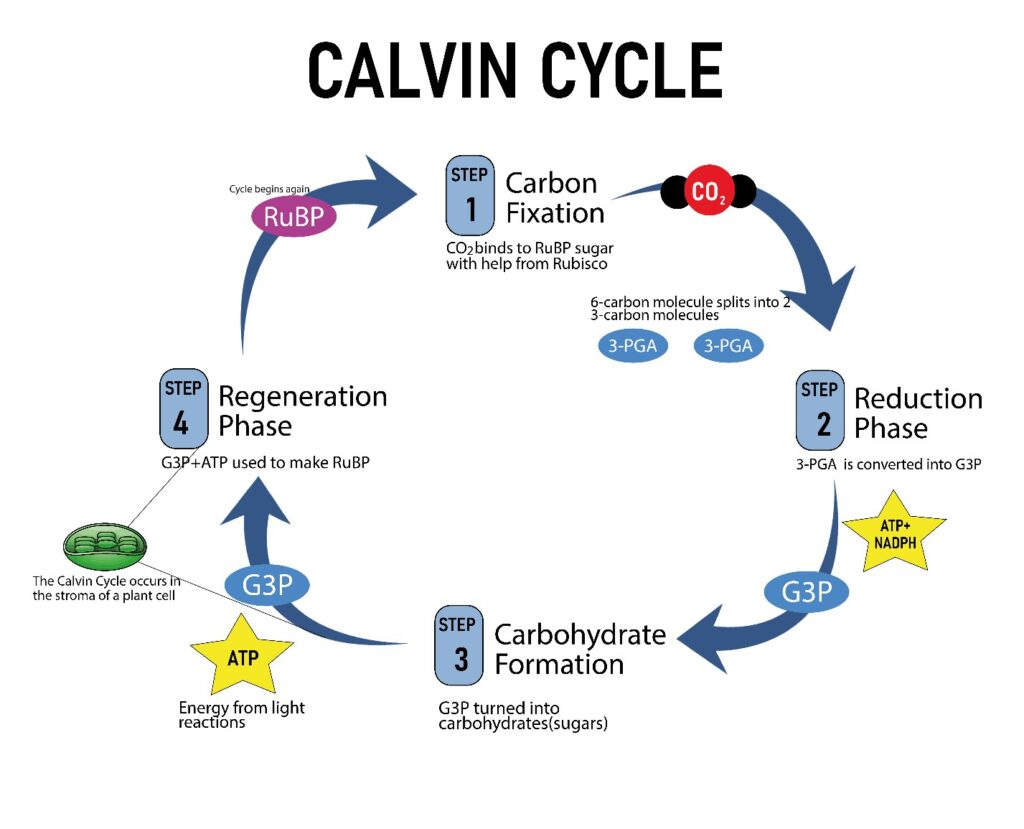
Figure 3. Calvin Cycle
Raffinose and theanderose are other indicators of difference between the two sugar sources. Both raffinose and theanderose effectively affect the growth and morphology of sugar crystals (Morel du Boil, 1996). In addition, it is known that raffinose, found in both sugar sources, is higher in beet sugar. Theanderose, on the other hand, is known only as a natural ingredient in cane sugar (Urbanus, 2014).
When examined in terms of their thermal behaviour, it can be said that there are distinctions between sugar cane and sugar beet. For example, in research with differential scanning calorimetry (DSC) thermogram, beet sugar has a sizeable endothermic peak. In contrast, sugar cane has one small endothermic peak and one prominent endothermic peak (Lu, 2016).
The sweetness, although some experts would like to argue this, is identical in both. The aroma is only different if you are an experienced baker or food critic, but typical consumers would not notice a difference.
According to the Republic of Turkey Ministry of Agriculture and Forestry, around one quarter (24%) of sugar production with sucrose in the world is made with sugar beet. In contrast, the remaining three quarters (76%) are made with sugar cane. Brazil and India, which produce the most sugar globally, make this production with sugar cane. China and Thailand, which come after these two countries, produce sucrose sugar with sugar cane and sugar beet. The European Union and America have an essential share in sugar beet production.
Plants are subjected to different processes while obtaining sugar from sugar cane and sugar beet. McHugh (2020) explains sugar production from sugar cane and sugar beet step by step;
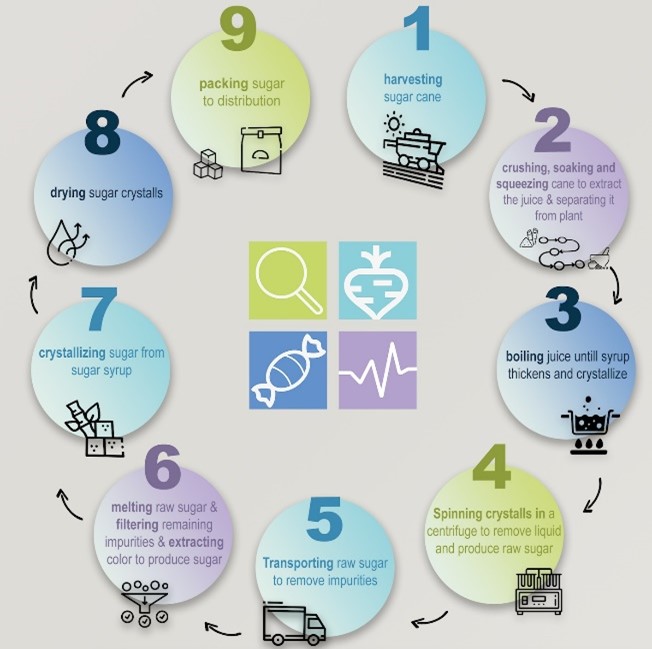
Figure 3. Sugar cane processing
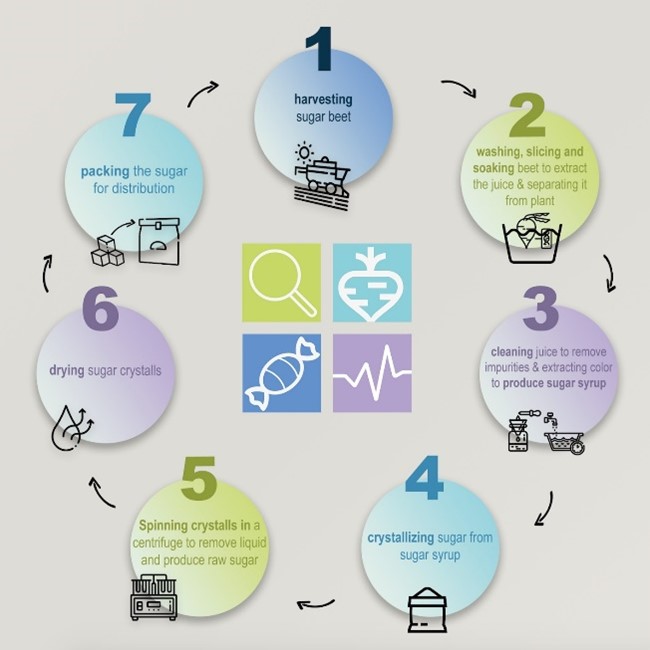
Figure 4. Sugar beet processing
Harvesting: Sugar beet and sugarcane harvested mechanically from the field are frequently sieved to remove dirt and rock fragments before loading them onto trucks and setting off for the factory.
Washing and Initial Preparation: Sugar beet and sugar cane coming to the factory are washed in water-sprayed belts or fully water-filled flues. In the rotating drum used as a washing station, the plants also rotate and rub themselves to remove the dirt. After washing, sugar beet and sugar cane are transferred to the factory using screws or belts. At this point where we see the first difference, sugar cane is crushed with swing-hammer shredders or heavily grooved crusher rollers. Sugar beet is cut into smaller pieces than french fries, and hot water is sprayed on the cut pieces. As a result of both processes, plant cells swell as preparation for extraction.
Juice extraction: The sugar cassettes are pumped towards the bottom of the tanks at the height of 10-20 meters. The water in the sugar cane is extracted by milling. An array of five mills compresses the sugarcane fibers to separate the water and the pulp, later used as a fuel source. A rotating shaft in the center of the tank carries the strips of sugar beets up, which is the opposite direction of the water flowing down. Initially, the juice, which is dark green colored, is collected in large containers, and the sugar concentration is determined.
Purification of Juice: Towers with a height of 10-20 meters are employed to purify and lighten the color of cane juice. While juice is given from the top of the tower, sulfur dioxide vapor is provided from the bottom, and the sulfur dioxide used for sulfidation rises from the tower. Soluble non-sugar substances are further separated from juice by carbonation or alkalization. Carbonation uses calcium carbonate or calcium sulfate to promote precipitation. The juice is heated and mixed with a calcium hydroxide slurry known as milk of lime to denature the proteins. Carbon dioxide gas bubbles can also be added at this point to precipitate the carbonation sludge that is filtered to lower the alkalinity and purify the water.
At the end of the purification period, which takes a few hours, the sludge is removed from the bottom of the tank, and the juice is removed from the top. Secondary filtration is applied to extract any remaining sugar from the sludge, and thus, a material called mud, which can be used later as fertilizer, is produced. The clarified juice is boiled in a serial vacuum evaporator until 50-65% sugar concentration. Each evaporator here has a higher vacuum pressure than the previous evaporator, resulting in sugar syrup has a lower boiling point as it progresses through the process. Sediment is removed from the top of the evaporators using paddle scrapers, producing a thick, almost colorless sugar syrup.
In this step, the syrup is evaporated until it is saturated with sugar crystals, which shape up through a process called seeding by using a single-stage vacuum pan. A milky pure sucrose solution suspended in alcohol and glycerin is the seed that is gently added to the syrup.
The small sugar grains in the solution help convert the sugar into crystals by drawing the sugar in the solution. Then, the water evaporates from the mixture boiled in a vacuum pan. The sugar crystals continue to turn into a paste known as massecuite, a mix of syrup and sugar crystals. Later, this mixture is taken into a large container called the crystallizer, where the massecuite is stirred and cooled slowly, and thus the crystallization process continues.
Centrifugation: Massecuite is added to a centrifuge containing a perforated basket, which rotates at 1,000-2,800 revolutions per minute, and is separated into sugar crystals and molasses. Molasses coming out of the lined centrifuge basket during centrifugation are pulled out of the centrifuge, removed from here, and sent to storage tanks. Sugar, on the other hand, remains in the lined centrifuge basket. Springwater is used to wash the crystals as they are centrifuged.
Drying and packaging: The moisture content of damp sugar crystals dried in hot air dryers decreases to 0.02%. Afterwards, the sugar is slowly rolled through heated air in a granulator. Next, dried crystals are separated by size with vibrating screens and placed in storage boxes. Finally, it is packaged for distribution.
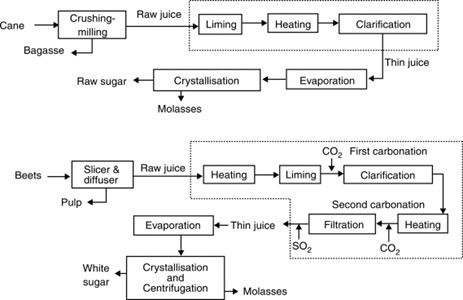
Figure 4. Singh R. (2015) Sugar refining by membrane processing
In brief, sugar cane and sugar beet are two widely used sources for sucrose production. Thanks to its resistance to a broader range of climatic conditions, sugar beet has proliferated in Europe, America, and many other countries. However, approximately 3/4 of the production is still made with sugar cane. The two plants have differences in important aspects such as cultivation, physical content, and processing. Perhaps one of the most important of these differences may be carbon fixation processes. In addition to this, they are inevitably subjected to different steps during the production phase.
.
.
CONTENT: Melisa Güçlü (Department of Food Engineering, METU)
REFERENCES
Cheesman, O. D. (2004). Background/sugarcane. In Environmental Impacts of Sugar Production (p. 6). essay, CABI Publishing. Retrieved from http://sherekashmir.informaticspublishing.com/603/1/9780851999814.pdf
Duraisam, R., Salelgn, K., & Berekete, A. K. (2017). Production of Beet Sugar and Bio-ethanol from Sugar beet and it Bagasse: A Review. International Journal of Engineering Trends and Technology, 43(4), 222–233. https://doi.org/10.14445/22315381/ijett-v43p237
T.C. TARIM VE ORMAN BAKANLIĞI. (n.d.). Dünya Şeker Sektörüne İlişkin Sorular. Retrieved from https://www.tarimorman.gov.tr/SDB/Menu/95/Dunya-Seker-Sektorune-Iliskin-Sorular.
FAO. (1994). DEFINITION AND CLASSIFICATION OF COMMODITIES. Home . Retrieved from http://www.fao.org/es/faodef/fdef03e.HTM.
Finkenstadt, V. L. (2013). A review on the complete utilization of the sugarbeet. Sugar Tech, 16(4), 339-346. doi:10.1007/s12355-013-0285-y
Lu, Y. (2016). Investigating the thermal behavior differences between beet and cane sugar sources (thesis). ProQuest Dissertations & Theses, Ann Arbor. Retrieved from https://www.ideals.illinois.edu/handle/2142/90912
McHugh, T. (2020, July 1). How Sugar Is Processed. Food Technology Magazine. Retrieved from https://www.ift.org/news-and-publications/food-technology-magazine/issues/2020/july/columns/processing-how-sugar-is-processed.
Monakhova YB, Diehl BW. Authentication of the origin of sucrose-based sugar products using quantitative natural abundance (13) C NMR. J Sci Food Agric. 2016 Jun;96(8):2861-6. doi: 10.1002/jsfa.7456. Epub 2015 Oct 22. PMID: 26362834.
Morel du Boil PG. 1997. Theanderose – Distinguishing Cane and Beet Sugars. Int.Sugar J. 99(1179):102-6.
Urbanus, B. (2014). Sensory differences between beet and cane sugars (thesis). Retrieved from https://www.ideals.illinois.edu/bitstream/handle/2142/49788/Brittany_Urbanus.pdf?sequence=1
The information contained in this document reflects only the view of the SuChAQuality project and in no way reflects the European Commission’s opinion for which cannot be held responsible for any use that may be made of the information it contains

